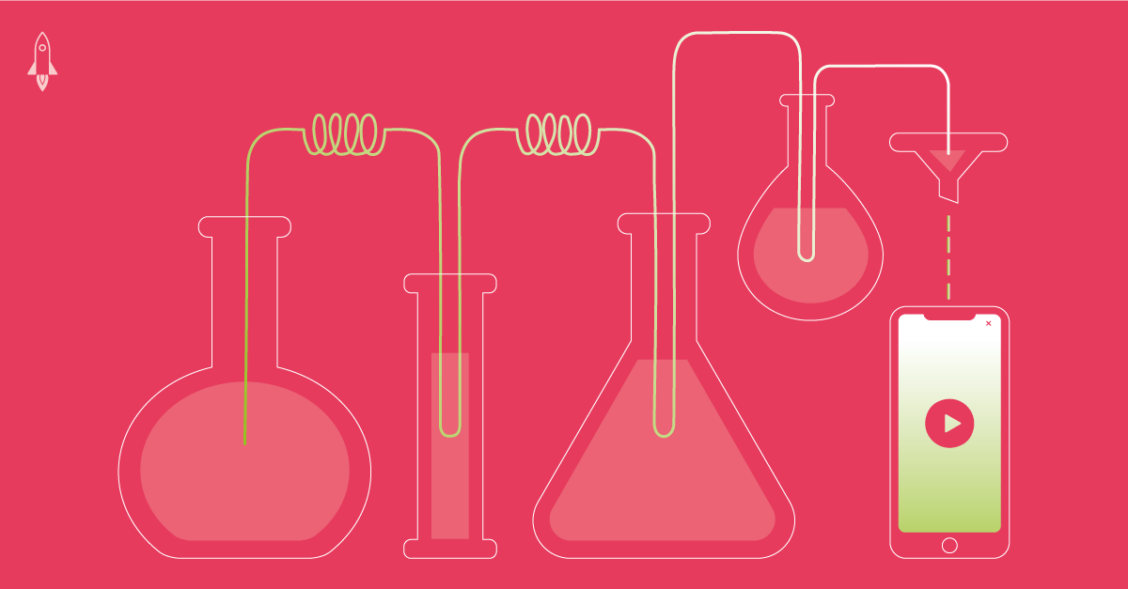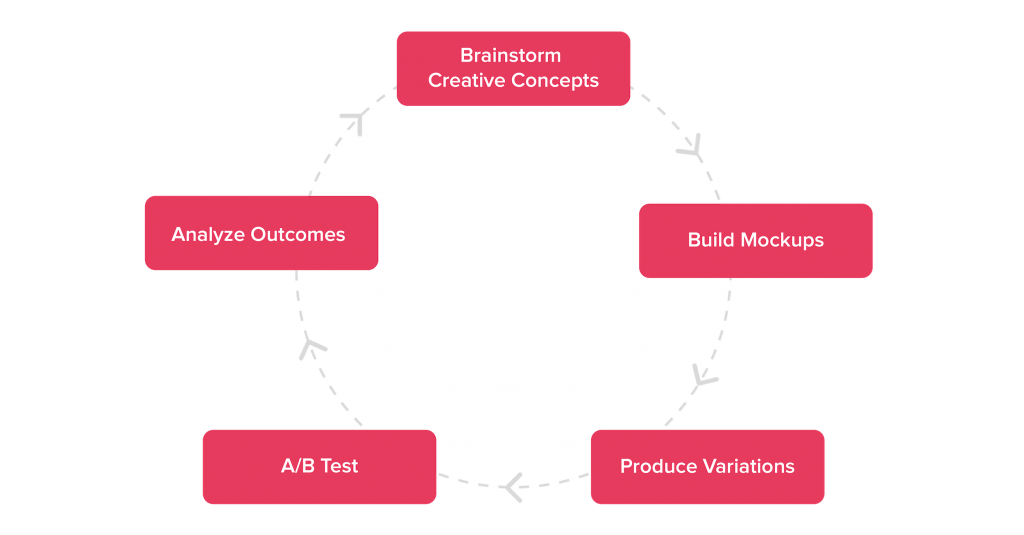
Nailing Creative Development to Make Your Advertising More Effective
The elements that go into a great ad, such as text, images, and buttons, shouldn’t be a mystery to any marketer. But the value of an ad creative testing framework is often underappreciated.
Testing has a long history in advertising. As far back as 1923, Claude C. Hopkins wrote in his famous book, Scientific Advertising, “Almost any question can be answered, cheaply, quickly and finally, by a test campaign.” In 2021, there are many more tools at a marketer’s disposal.
The newest development, automation, enables marketers to test every single element of a campaign, thousands of times over. This state of play can overwhelm marketers. Too many options make it difficult for marketers to use the data at their disposal. Messy testing processes can even promote poorly-performing ads and increase the chances of leaving the best on the cutting-room floor.
To scale your user acquisition effectively, you need a bulletproof testing process that selects the best ad at every new iteration. At Liftoff, we developed a framework in-house, used by the Ad Creative team to develop campaigns for many clients in different categories. By using the framework you can begin to start creating an efficient cycle that will help you build better ads.
5 Steps to Building Better Ads
There are several steps in our ad building process. A/B testing is a critical part of this process, but it’s not the full picture. In fact, testing creative elements is only step four in a cycle of ad creation:

Here’s each step in more detail:
- Brainstorm creative concepts: First, we develop narratives for an ad: what will happen, which product to show, and what outcome we plan to deliver (such as a reward for clicking through). These ideas inform all the creative variations that follow.
- Build mockups of the best ideas: From all of the ideas we have, we then make the ads. For bigger campaigns (particularly video), we usually storyboard the creative to guide production.
- Produce creative variations: Once we have a general creative concept and a single ad created, we begin to make variations of the ad, changing text, button colors, and so on.
- A/B test the creative: Next, it’s time to set up experiments (in the form of campaigns) that compare our creative variations’ performance.
- Analyze the outcome: The final step in the cycle is to monitor our experiments’ performance to see how well those creatives do.
Follow this simple structure to frame your ad creative production process. It’s easy to find new components to flesh out an ad creation process that makes sense for your team. Let’s now talk about what Liftoff’s Ad Creative Producers do when we’re onboarding a new app to show you how we think when creating new ads.
Improving Your Approach To The Creative Ad Production Process
It takes new ways of thinking to improve creatives. With every new campaign, we hone in on what users find more interesting. Here are some things we think about when trying to discover improvements:
1. Find the key benefit of the app: Every app has a few features that make users excited. We want to find out what that benefit is early in our A/B testing plan to develop from there.
2. How can we make the concept better? This question usually comes before building an animation or interactive that will provide the user with more information in a simple way.
3. Small changes can make a big difference: Tiny optimizations frequently apply across creatives.
4. Optimize! Continue to validate the hypothesis and strategy through A/B testing.
Ad Creative Frequently Asked Questions
Now that we’ve approached a process and improved our thinking let’s tackle critical questions you may have regarding the process.
What’s the Difference Between Incremental Tests and Concept Tests?
There are two kinds of tests you can conduct: incremental and concept testing. Incremental tests experiment with a single aspect of an ad, such as background or a single foreground image. Concept tests pitch two completely different creatives against each other.
Incremental testing allows you us to find the small wins that build best practices for a customer. Once you’ve optimized significantly in one direction, more extensive concept tests will enable us to find a completely new path to find opportunities. If marketers create a new offering, concept tests allow them to hone in on what works before optimization can occur.
How Do I Come Up With so Many New Concepts?
When adopting an ad creation process, you’ll quickly find that it’s often more challenging to generate entirely new concepts versus delivering variations on those concepts. Coming up with new ideas is difficult, especially without support or a process you fully own.
Keep this rule in mind: because it’s hard, take your time. Your goal should be to produce a steady stream of new concepts that outperform your competitors, not just your older ads. So, work to create new ideas in a way that fits your and your team’s preferences and capabilities. Brainstorms are only one of many techniques that help the Ad Creative team generate ideas, but we also like to share inspiration from creatives in different regions, ads in the wild, and from the world around us.
What Are Some Tips on Conducting A/B Tests for Creative Ads?
Testing can sometimes become a matter of quantity over quality. As Eric Seufert of Mobile Dev Memo writes, “the only way to optimally pair creative with segments that ad platforms algorithmically define is to test a massive number of ad creatives.” While that’s true, testing must have a goal in mind, or your campaign performance can drop massively.
Anything you add or change in a campaign creates fluctuation, whether positive, negative, or neutral. And what feels like a few tests can become an aggregate of thousands of different variations that don’t perform as well as if you were only running your best ad. You must balance testing and performance to even out potential dips or spikes in spend.
If that doesn’t change your mind on mass testing, bear in mind that we’ve seen a typical win rate (where new creative A beats high-performing creative B) reach 20 to 25% over the years. It’s remarkable that one in four ads has a chance to beat the status quo, but it still means for every four tests you could be running three poorly-performing ads. Knowing what doesn’t work is a valuable exercise, but marketing outcomes should not suffer from over-eager testing.
How Long Should I Be Testing an Ad For?
Time spent on a test isn’t as important as the number of installs and impressions an ad receives. Depending on your app’s popularity and budget size, tests will run quicker or slower. This makes setting an overall benchmark challenging. Here are the main metrics Liftoff’s creative team uses to ensure a test is going to plan:
- Ads tests must be statistically significant, meaning that there’s no chance that higher performance was due to anything other than the creative. At Liftoff, we look for a confidence interval of 0.01 or below, meaning that we are 99% (or more) confident in the results shown. If you want a primer on statistical significance, Harvard Business Review has a full write up to learn from.
- Each ad variant must receive a minimum number of impressions. Your testing figure will vary depending on traffic (some ads will need hundreds of impressions, others hundreds of thousands).
- We also set a target for installs. This benchmark will vary depending on your app. Usually we need around 80 installs to analyze the best-performing ad.
Why Do I Need to Produce New Ads Constantly?
You might have heard of the Mere-exposure effect, which describes the phenomenon where “people tend to develop a preference for things merely because they are familiar with them.” Advertising operates on exposing the brand to people as often as possible to build familiarity. However, ads themselves have a half-life on a viewer’s attention. Known as “ad fatigue,” users will quickly get bored if they see the few same ads over and over again.
An advertiser should seek to find that point of deterioration where new ads begin to perform less well. You must replace a creative before performance collapses entirely. To do that, you need to start looking for a replacement as soon as the creative launches.
4 Small but Powerful Best Practices Behind Great Mobile Ads
There are a handful of best practices that help good ads become great. Here’s what we always consider when creating new ads:
Define objectives for your creative concepts, and develop a straightforward story around them
- For ads to be effective, they need to be understood by the user. Simplicity always wins.
- Don’t stuff your ads with features—it will dilute your creative and confuse your audience.
Be contextually creative
- Ensure your creative is relevant to the user’s state of mind.
- Make your ads cross-screen ready and available across all formats.
- Mobile ads are different from social ads. What does well on Facebook may not perform well elsewhere.
- Localize! It’s almost impossible to succeed in different markets with one language.
Use and reuse great assets
- Ads must load quickly on mobile. File sizes must be small and adhere to technical restrictions.
- Use high-resolution assets. Most phones have retina displays which require double the amount of pixels (640×100 versus the usual 320×50).
- Reuse your collateral to create consistent App and/or Play Store pages.
Guide users with clear CTAs
- Create a consistent, clear and direct call-to-action.
- Work on your wording: “Tap to expand” or “Play the games” could be more effective than “Tap to learn more.”
- Any button should have a clear CTA with a tappable ad element. Don’t include buttons that users cannot use.
Go Get ‘Em, Tiger
Surprising users with delightful copy is one thing, but making sure your ad sparkles throughout is much harder. By using Liftoff’s framework, you can begin to iterate on your best-performing ads faster and more effectively to get the most out of your user acquisition efforts.
For more on ad creatives, take a look at our newly-released Ad Creatives Index, which you can download for free today to learn more about the different types of creative formats. You can also learn how to optimize video campaigns with lead Ad Creative Producer Thomas Zukowski or discover the benefits of banner ads with an in-depth study on the blog.